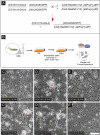Establishment of Drosophila intestinal cell lines as tools for multiomic screening and deciphering intestinal biology
- PMID: 40897748
- PMCID: PMC12405456
- DOI: 10.1038/s41598-025-17336-z
Establishment of Drosophila intestinal cell lines as tools for multiomic screening and deciphering intestinal biology
Abstract
The Drosophila intestine is a powerful model for stem cell dynamics and epithelial biology, yet no intestinal derived cell lines have been available until now. Here, we describe the establishment of Drosophila intestinal cell lines. The cell lines were derived from the embryonic intestine through specific RasV12 expression and show continuous proliferation and the ability to be frozen and re-thawed. Each derived cell line exhibited morphological and cellular heterogeneity. Single-cell RNA sequencing confirmed their intestinal origin and cell populations with unique enriched signaling pathways. In addition, L15, one of the three lines, formed 3D spheroids that displayed epithelial polarity. Together, these lines provide an additional resource for studying intestinal development, epithelial organization, and pest management.
Keywords: Drosophila; Cell line; Intestine; Spheroids; Transcriptomics.
© 2025. The Author(s).
Conflict of interest statement
Declarations. Competing interests: The authors declare no competing interests.
Figures





Similar articles
-
Prescription of Controlled Substances: Benefits and Risks.2025 Jul 6. In: StatPearls [Internet]. Treasure Island (FL): StatPearls Publishing; 2025 Jan–. 2025 Jul 6. In: StatPearls [Internet]. Treasure Island (FL): StatPearls Publishing; 2025 Jan–. PMID: 30726003 Free Books & Documents.
-
Silk-Ovarioids: establishment and characterization of a human ovarian primary cell 3D-model system.Hum Reprod Open. 2025 Jul 10;2025(3):hoaf042. doi: 10.1093/hropen/hoaf042. eCollection 2025. Hum Reprod Open. 2025. PMID: 40799620 Free PMC article.
-
A collection of split-Gal4 drivers targeting conserved signaling ligands in Drosophila.G3 (Bethesda). 2025 Feb 5;15(2):jkae276. doi: 10.1093/g3journal/jkae276. G3 (Bethesda). 2025. PMID: 39569452 Free PMC article.
-
Drosophila Intestine as a Model to Study Tumors.Adv Exp Med Biol. 2025;1482:101-117. doi: 10.1007/978-3-031-97035-1_6. Adv Exp Med Biol. 2025. PMID: 40745138 Review.
-
Unveiling the Molecular Pathogenesis of MCPH: Insights From Drosophila Model System.Dev Growth Differ. 2025 Aug;67(6):354-374. doi: 10.1111/dgd.70019. Epub 2025 Jul 19. Dev Growth Differ. 2025. PMID: 40682423 Review.
References
MeSH terms
Substances
Grants and funding
LinkOut - more resources
Full Text Sources

